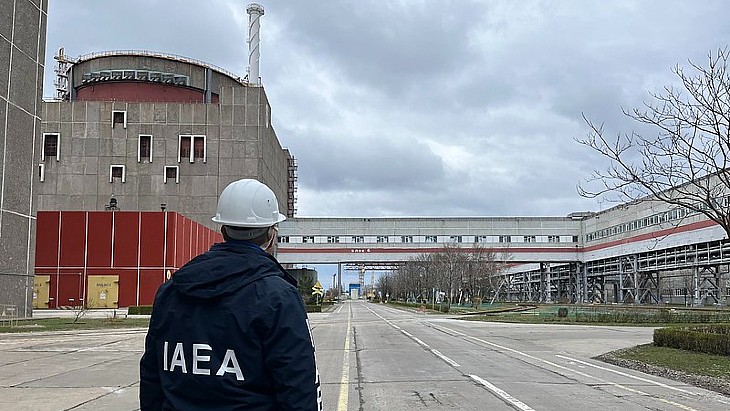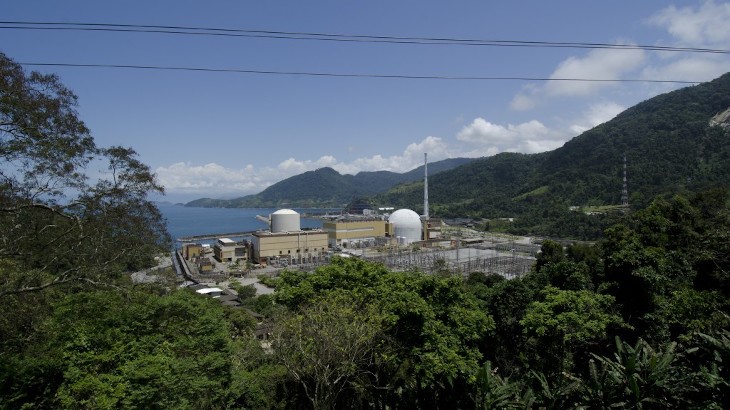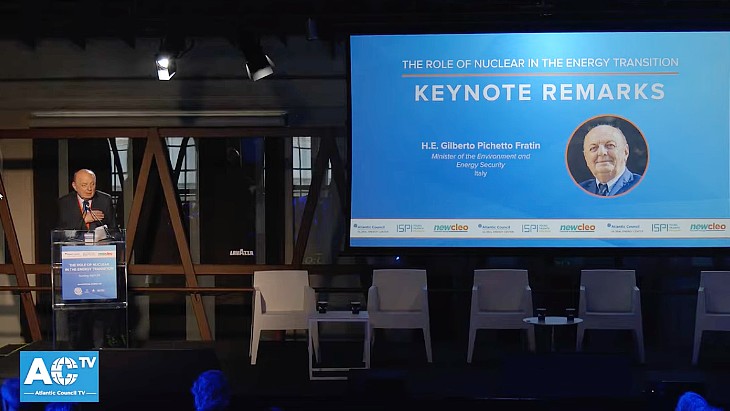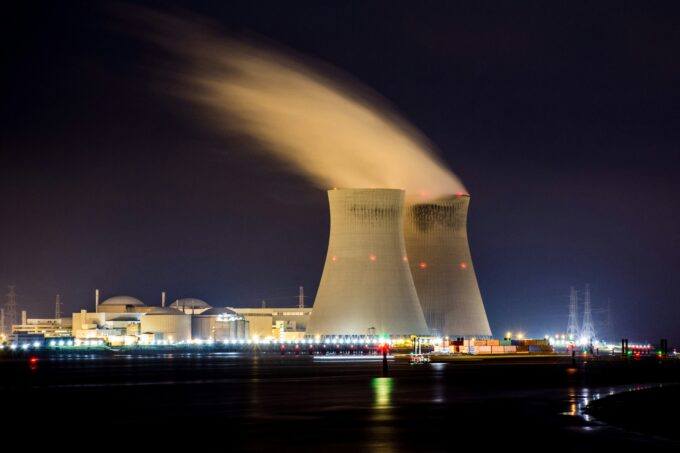NUKE NEWS
Energoatom and Hyundai E&C sign cooperation memorandum
14 May 2024
The memorandum of cooperation signed by the Ukrainian and South Korean companies covers cooperating on the design, construction and commissioning of new nuclear power units in Ukraine.
 (Image: Ukraine's Ministry of Energy)
(Image: Ukraine's Ministry of Energy)The agreement was signed by Energoatom's Petro Kotin and Korean Hyundai Engineering and Construction Executive Vice President and Operations Director Choi Young in the presence of Ukraine's Energy Minister Herman Halushchenko and South Korea's Ambassador to Ukraine Kim Hyun-Tae.
Halushchenko said the agreements were important in terms of the plans for new Westinghouse AP1000 units at the Khmelnitsky nuclear power plant: "It is important that, together with the Korean side, we sign this memorandum during the war and, without waiting for its end, move forward. I am confident that together we will build an energy industry in Ukraine that will meet the best global standards."
The ambassador said the memorandum would "contribute to the development of Ukrainian-Korean cooperation in the nuclear industry, in particular, the exchange of experience in the field of nuclear technologies".
Kotin said: "South Korea"
IAEA warns against attacks on, or from, Zaporizhzhia nuclear power plant
International Atomic Energy Agency Director General Rafael Mariano Grossi has restated that "there must be no attack of any kind from or against this major nuclear facility".
 The six reactors are now all in cold shutdown (Image: IAEA)
The six reactors are now all in cold shutdown (Image: IAEA)In his latest update on the situation at the six-unit Zaporizhzhia nuclear power plant, which has been under Russian military control since early March 2022, Grossi said that on the question of military action targeting the plant, or being launched from it "the five concrete principles - widely supported by the members of the United Nations Security Council - are very clear".
He said that the agency's experts at the plant had heard military activity on most days "including artillery and rocket fire some distance away ... as well as small arms fire both near to and further away from the site". There had also been air-raid sirens on Wednesday and Thursday.
The IAEA was "aware of reports alleging that a training base for drone operators as well as drone launch pads have been deployed near the ZNPP's reactor unit 6 and its training centre. The IAEA experts have not seen any evidence of drones being launched, or the presence of training facilities or launching pads, within the site perimeter, but have requested access to the rooftop of a nearby laboratory building. The ZNPP has informed the IAEA team that the request is under consideration".
Since September 2022 there have been IAEA experts stationed at the facility, helping to monitor the situation and seeking to reduce the risks to safety and security at a place which is located on the frontline of Russian and Ukrainian forces.
They have carried out regular walkdowns across the site, although there have been some areas where they have had to request access a number of times before being allowed to visit. This week they have visited the two fresh fuel storage facilities, performed radiation monitoring along the site perimeter and measured the levels of the site's sprinkler ponds, which they reported to have enough water to provide cooling to the six reactors.
Another issue that the IAEA has been monitoring has been the staffing situation at the plant. The Russian operators say there are currently 5000 staff, an increase on last year but "still significantly fewer than it had before the conflict", the agency added. There are 800 open positions, and the operators have told the IAEA that staffing levels at Rosatom-operated nuclear power plants are generally "significantly lower than the corresponding staffing levels of Ukraine". The IAEA says its experts are "prevented from freely talking to main control room staff, affecting the agency's ability to independently assess the knowledge and experience of these personnel that are essential to maintaining nuclear safety at the ZNPP".
Grossi said: "We are continuing to monitor the staffing situation closely, as it is of vital importance for nuclear safety and security. For this purpose, our experts would also require an opportunity to discuss with the operators of the main control rooms, and other qualified staff."
The IAEA said that its teams at Ukraine's other nuclear power plants of Khmelnitsky, Rivne and South Ukraine, plus at Chernobyl, "reported that nuclear safety and security continues to be maintained".a has developed nuclear energy and expertise in the nuclear industry. Energoatom and Ukraine as a whole are interested in the development of our cooperation with the Hyundai company, which is one of the world leaders in this market."
The agreements build on a letter of intent that was signed by the two companies in November 2023. In May 2022 Westinghouse and Hyundai E&C signed a strategic cooperation agreement to jointly participate in global AP1000 plant opportunities and last month a ceremony was held to mark the start of the project to build what will become unit 5 at Khmelnitsky NPP.
Ukraine has 15 nuclear units which could generate about half of its electricity, including the six at the Zaporizhzhia nuclear power plant which has been under Russian military control since early March 2022. Ukraine's nuclear expansion plans include proposals for nine new AP1000 reactors across the country.
Khmelnitsky's first reactor was connected to the grid in 1987, but work on three other reactors was halted in 1990, at a time when unit 3 was 75% complete. Work on the second reactor restarted and it was connected to the grid in 2004. A project to complete units 3 and 4 is under way - last month, the Ukrainian Cabinet put forward a draft law on their construction/completion. Halushchenko said earlier this year that unit 3 could come into operation in as little as two and a half years.
Two of the new AP1000s are due to become the fifth and six units at Khmelnitsky and would bring the plant's total capacity beyond that of the six-unit Zaporizhzhia plant which has been under Russian military control since early March 2022. During their talks, Energoatom and Hyundai E&C discussed all these projects as well as agreements with Holtec International on the construction of factories for the production of equipment for small modular reactors and containers for used nuclear fuel.
10 May 2024
Estonian parliament begins preparations for nuclear power programme
09 May 2024
Members of Estonia's parliament, the Riigikogu, have submitted the draft resolution which will allow preparations to begin for the adoption of nuclear energy in the country and the creation of a suitable legislative and regulatory framework.
.jpg?ext=.jpg) The Riigikogu building is situated in the courtyard of Toompea Castle and was the first public building in Estonia which was designed to have electric power (Image: Riigikogu Photo Archive/Martin Siplane)
The Riigikogu building is situated in the courtyard of Toompea Castle and was the first public building in Estonia which was designed to have electric power (Image: Riigikogu Photo Archive/Martin Siplane)
The draft calls for the Riigikogu to pass a "fundamental decision" on whether to allow production of nuclear energy in Estonia. According to the Riigikogu, the draft is mainly based on the analysis conducted by the Nuclear Energy Working Group in 2021-2023 which concluded that the adoption of nuclear energy in Estonia was feasible. The findings of that study were submitted to the Estonian government in March.
The 55 members of the Riigikogu who submitted the draft "support the preparations for the adoption of nuclear energy and the creation of a necessary legislative framework for it", including the drafting of the Nuclear Energy and Safety Act and supplementing the existing legislation, the establishment of nuclear regulatory institution, and the development of "sectoral competences".
According to the draft's explanatory memorandum, the adoption of nuclear power would provide a "controllable and continuous generation capacity" to balance fluctuations in renewable energy generation, help Estonia reach its climate neutrality target, ensure "stable and affordable electricity" in the long term, promote research and development, bring economic benefits and create jobs for local people. It would also bring challenges such as the training of a qualified workforce, handling and storage of used nuclear fuel, and emergency preparedness. "To address these, it is essential to ensure appropriate regulation, supervision, competence development and timely and adequate funding that would guarantee the safe and responsible use of nuclear energy when it is adopted," it states.
The draft does not grant the right to build a nuclear power plant in Estonia, the Riigikogu said.
Estonia's current domestic electricity generation is dominated by fossil fuels, but the country is seeking to reach net-zero emissions by 2050 and is looking at nuclear power as a reliable and low carbon option to diversify its energy mix by 2035 when it plans to phase out its use of domestic oil shale. A draft law which would suspend the issuance of new domestic oil shale mining permits until the end of 2025 - to allow time for climate laws to be drafted - has been announced by the Estonian government and is being sent to parliament for consideration.
An IAEA mission to Estonia reported in October that the country had developed a comprehensive assessment of its nuclear power infrastructure needs to decide whether to launch a nuclear power programme. In February 2023, Estonia's Fermi Energia announced it had selected GE Hitachi Nuclear Energy's BWRX-300 SMR for potential deployment in the Baltic country by the early 2030s.
.jpg?ext=.jpg) The Riigikogu building is situated in the courtyard of Toompea Castle and was the first public building in Estonia which was designed to have electric power (Image: Riigikogu Photo Archive/Martin Siplane)
The Riigikogu building is situated in the courtyard of Toompea Castle and was the first public building in Estonia which was designed to have electric power (Image: Riigikogu Photo Archive/Martin Siplane)Hungary and China sign nuclear energy cooperation agreement
10 May 2024
A memorandum of understanding on the peaceful uses of nuclear energy has been signed by the China Atomic Energy Authority and Hungary's Ministry of Foreign Affairs.
 Hungary's Foreign Minister Peter Szijjarto, right, hosted talks (Image: Peter Szijjarto/Facebook)
Hungary's Foreign Minister Peter Szijjarto, right, hosted talks (Image: Peter Szijjarto/Facebook)
The agreement was one of 18 covering a wide variety of areas signed during President Xi Jinping's visit to Hungary on Thursday.
A joint statement issued by the two countries on the establishing of an over-arching All-Weather Comprehensive Strategic Partnership for the New Era, said: "The Chinese side will continue to encourage capable Chinese enterprises to invest in Hungary. The two sides will promote orderly cooperation in emerging fields including clean energy, artificial intelligence, mobile communication technology and nuclear energy and technology."
Hungary's President Viktor Orban said, after his talks with the Chinese president: "The Hungarians have serious ambitions. The previous 100 years, the 20th Century, was a shameful one for Hungary. It was a century in which we lost, a century in which we suffered extremely heavy losses of historic proportions. And the concept driving the Hungarians is that we want to win the 21st Century, and not lose it. And to win we need partners, investors, trading partners and the world’s most advanced technology."
He added: "I will make special mention of something which is not only an economic fact, but also an expression of confidence: the fact that we can extend our cooperation to the whole spectrum of the nuclear industry, where up until now there has been no cooperation between our two countries. This holds great potential, because in this respect - in terms of the nuclear industry - Hungary has considerable international experience and prestige, as we have been involved in this industry for more than 50 years, and currently the largest nuclear development in Europe is taking place in Hungary.
"Our plan is that by the beginning of the next decade the share of Hungary's energy provided by nuclear power will be between 60 and 70 per cent."
In the text of his published remarks, President Xi said the two countries would "connect our development strategies more closely, deepen economic, trade, investment, and financial cooperation, and advance the Budapest-Belgrade railway and other key projects. We will expand cooperation in emerging industries and foster new quality productive forces to empower and facilitate economic and social development of the two countries".
The official statements and publications during the visit do not yet appear to include detail of the content of the memorandum of understanding on nuclear. China is the fastest growing generator of nuclear energy. According to World Nuclear Association figures, it currently has 56 operable reactors with a capacity of 54 GW - and it has 27 more reactors under construction which would provide 28.9 GW more capacity. Hungary currently has four operable nuclear reactors with a capacity of 1.9 GW, supplying about 40% of the country's electricity. It has also embarked on the Paks II project which would see Russia's Rosatom supply two VVER-1200 reactors.
 Hungary's Foreign Minister Peter Szijjarto, right, hosted talks (Image: Peter Szijjarto/Facebook)
Hungary's Foreign Minister Peter Szijjarto, right, hosted talks (Image: Peter Szijjarto/Facebook)Eletronuclear updates Angra 1 lifetime extension progress
13 May 2024
Brazilian nuclear power plant operator Eletrobras Eletronuclear says it is on track to complete all the steps required to get approval for extended operation of the Angra 1 unit.
 Angra 1 and 2 (Image: Eletronuclear)
Angra 1 and 2 (Image: Eletronuclear)Angra 1, Brazil's first nuclear power unit, is a 609 MWe pressurised water reactor that was first connected to the grid in 1982. Eletronuclear is seeking a lifetime extension from 40 to 60 years.
Getting a lifetime extension is a long and complex process and years of preparation had already gone into it even before the initial request for renewal of its operating licence was submitted to the Brazilian Nuclear Energy Commission (CNEN) in 2019. Eletrobras said that during 2023 it submitted 16 reports to the regulatory body, including assessments of safety factors as defined by the International Atomic Energy Agency (IAEA).
It said it had also responded to 166 follow-up questions from CNEN by the end of last month. And it had also carried out the third and final Periodic Safety Reassessment, a document produced every 10 years looking at things such as safety performance, emergency planning, equipment qualification and management systems.
The company also uses the US Nuclear Regulatory Commission's License Renewal Application process and is preparing next month for a fourth visit by the IAEA for a Safety Aspects of Long Term Operation (SALTO) mission - the previous ones were held in 2013, 2018 and 2022.
José Augusto do Amaral, superintendent of Operational Support Engineering and responsible for the LTO, said: "The negotiation process with [CNEN] should last until the end of this year to finalise the steps. But the company is prepared and continues to have constant dialogue ... we are managing to demonstrate that Angra 1 will be able to continue operating efficiently and safely."
Measures already taken to extend the service life for a further 20 years include new steam generators, changing the reactor pressure vessel cover and replacing the main transformers, the company says, as well as implementing ageing/obsolescence management systems. It estimates safety and modernisation spending of around BRL3 billion (USD585 million) between 2024 and 2028. it will get short term financing from its main shareholders, ENBPar and Eletrobras, while negotiations are completed with the US Export-Import Bank for the full modernisation programme.
Angra 1 reached criticality in 1982 and entered commercial operation in 1985. The pressurised water reactor (PWR) has a design capacity of 640 MWe (net capacity 609 MWe). Eletrobras Eletronuclear also operates Angra 2, a 1275 MWe (net) PWR which began commercial operation in 2001. Together with Angra 2 it generates about 3% of Brazil’s electricity. Work on the Angra 3 project - to feature a Siemens/KWU 1405 MW pressurised water reactor - began in 1984 but was suspended two years later, before construction began. The scheme was resurrected in 2006, with first concrete in 2010. But, amid a corruption probe into government contracts, construction of the unit was halted for a second time in 2015, when it was 65% complete. It resumed again in November 2022 - at the time of the project’s revitalisation, Eletronuclear’s aim was to start operations by the end of 2026. However, work has again faced interruptions pending agreement with local authorities on "socio-environmental" compensation payments.
Brazil also began a process to identify sites for new nuclear power plants in 2022 - its National Energy Plan to 2050 said the country aimed to add 10 GW of nuclear capacity in the next 30 years.
Turbine building roof installed at Akkuyu 2
13 May 2024
The three-month process of installing the roof on the turbine building of the second unit at Turkey's Akkuyu nuclear power plant has been completed.
 One of the sections is lifted under clear night skies (Image: Akkuyu Nuclear JSC)
One of the sections is lifted under clear night skies (Image: Akkuyu Nuclear JSC)
The roof is formed from nine sections, weighing between 95 and 175 tonnes and measuring 61 metres long, with a Liebherr 13000 crawler crane used. Each section had to be installed to an accuracy of within 10 millimetres.
Sergei Butskikh, first deputy director general of Akkuyu Nuclear JSC, said: "Installing roof trusses in a turbine hall is a complex task that requires a high degree of attention to detail and flawless execution. Despite the strict schedule and difficult weather conditions, the team of builders successfully completed the task. We are proud of the results achieved and thank each employee for their diligence and professionalism. At the next stage, we will begin installing the main units and components of the turbogenerator unit."

The section is lowered into place (Image: Akkuyu Nuclear JSC)
Akkuyu, in the southern Mersin province, is Turkey's first nuclear power plant. Rosatom is building four VVER-1200 reactors, under a so-called BOO (build-own-operate) model. According to the terms of the 2010 Intergovernmental Agreement between the Russian Federation and the Republic of Turkey, the commissioning of the first power unit of the nuclear power plant must take place within seven years from receipt of all permits for the construction of the unit.
The licence for the construction of the first unit was issued in 2018, with construction work beginning that year. Nuclear fuel was delivered to the site in April 2023. Turkey's Nuclear Regulatory Agency issued permission for the first unit to be commissioned in December, and in February it was announced that the reactor compartment had been prepared for controlled assembly of the reactor - and the generator stator had also been installed in its pre-design position.
The aim is for unit 1 to begin supplying Turkey's energy system in 2025. When the 4800 MWe plant is completed it is expected to meet about 10% of Turkey's electricity needs, with the aim that all four units will be operational by the end of 2028.
 (Image: Screengrab from Atlantic Council TV/Youtube)
(Image: Screengrab from Atlantic Council TV/Youtube)